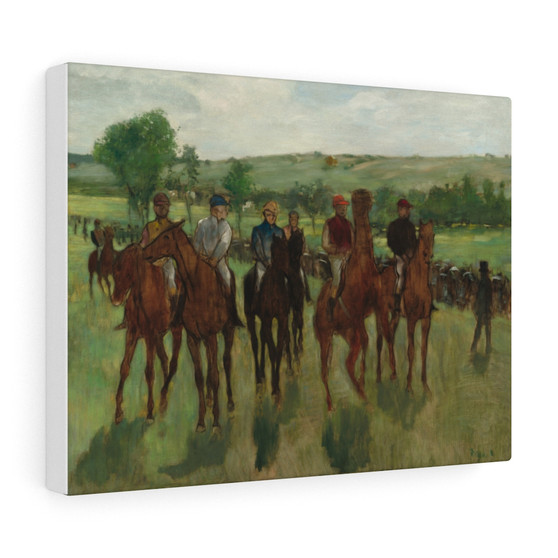Edgar Degas
BlogAdmin on 27th May 2022
Hilaire-Germain-Edgar De Gas (1834-1917), also popularly known as Edgar Degas, was born in Paris, France in 1834. He was the eldest son of Augustin De Gas’s five children.
His father was a wealthy banker who wanted his son to become a lawyer. Though his father had recognized his son’s artistic talent, Degas had to enroll in a law school. But soon, he dropped out of law school.
Worth of Degas’s Paintings
Degas was a French Impressionist artist famous for his pastel drawings and oil paintings. He specializes in painting with dance as the subject and more than half of his works depict works on dance and dancers.
The record price that his painting ‘ Danseuse au repos‘ fetched in the 1998 auction was $37mn. Degas’s other 1880 painting ‘Daseuses a la barre‘ sold at Christie’s in London for British Pound 13.48 million.
Edgar Degas painted 626 artworks during his lifetime.
Most Beautiful ‘Ballerinas’
Painting Balle dancers was one of his main subjects. Degas is said to have announced once that ‘people call me the painter of dancing girls. He also confessed that his main interest in dancers lies in rendering movement and painting pretty clothes.
His ‘blue dancers‘ painted in 1899, which is in Pushkin Museum, Moscow, Russia, is a very famous artwork on the subject of painting. The following are the 8 most beautiful ballerinas Deas is so famous for:
The Dance Class:
This is the first of Degas’ ballet dancers’ scenes. The dancer in the centre is Josephine Gaujelin who went on to become an actress at the Gymnase, a theatre known for its comedies and popular dramas. Gaujelin posed in a dance costume for a number of his drawings when Degas worked on his first ballet pictures.
The reason that he preferred painting with dance as subjects is that they were easier to sell and Degas needed money. Degas was a perfectionist and he wanted the movements of the dancers, or ballerinas, to be as close to perfection as possible.
Experts believe that Degas made the ballerinas attend the dance rehearsals of French mas Jules Perrault at Paris Opera House. This painting ‘The Dance Class’ shows one ballerina executing an ‘attitude’ as Perrault looks on.
It shows other dancers practising their dance moves while waiting their turn.
Musicians on the Orchestra
Degas painted the Orchestra Musicians in 1872. This painting is presently in Stadel Museum, Frankfurt, Germany. He revised this painting a few years later, enlarging it and turning the horizontal format into a vertical one.
He also painted over parts of the initial composition.
The Foyer of the Opera at Rue Le Peletier
Edgar painted this piece of art in 1872 and it is presently kept in Musee d’Orsay, Paris. There are 10 ballerinas portrayed in a great hall and white-clad Louis Francois Merante, an instructor at the opera house is seen giving orders.
Opera at Rue Le Peletier is an old opera house that burned down in 1873. By far the largest opera house in the world at that time, this magnificent monstrosity employed 7000 people including a corps de ballet of 200.
Rehearsal of a Ballet on Stage
This beautiful painting on ballerinas that Edgar painted in 1874 is presently in Musee d’Orsay, Paris, France. This painting is described as an allusion to the new visual technique of photography.
The painting was immediately noticed at the first impressionist exhibition in 1874.
The painter Giuseppe De Nittis wrote to a friend saying ‘I remember a drawing that must have been a dance rehearsal and I can tell you it was extremely beautiful: the muslin costumes were so diaphanous, and the movements so true to life that it has to be seen to be believed; it is just impossible to describe. ‘
The Star (Dancer on Stage)
Edger painted the piece of art in 1878 and it is presently in Musee d’Orsay, Paris, France. In this painting, the star of the show is dancing solo on an empty stage.
On the left, one can see a shadow hiding behind the curtain. This is said to be the young dancer’s patron.
Getting behind the scenes was not easy and it was a privilege paid for by wealthy male subscription holders who often flirt with the dancers.
The Pink Dancers, Before the Ballet
This painting took place in 1884 and is presently on show in Ny Carlsberg Glyptotek, Copenhagen, Denmark. Around 1880, Edgar changed his palette from greys to brilliant colors, ranging from red to russet. This came with a change of style and technique in which pastels became his dominant medium.
The drawings Degas made backstage were few compared with the number he produced in his studio, where he paid a small amount of money to ballerinas to pose. Once the police morals unit visited Degas’s studio wanting to know why so many little girls were coming and going to the studio.
This is one of Degas’s famous paintings that sold for handsome amounts. This painting happened in 1899 and is presently in Pushkin Museum, Moscow, Russia.
The Little Fourteen Year Old Dancer
Edgar made this life-size sculpture in 1880 is on display in the Metropolitan Museum of Art in New York, USA. Degas always suffered from poor eyesight and would ultimately go blind.
So he started to make wax figures, partly for his own pleasure partly to have something he could mould and feel and not just visualize.
He presented the only sculpture at the 6th impressionist exhibition in the spring of 1881. This was not warmly received when she first appeared and it provoked strong reactions from critics.
















